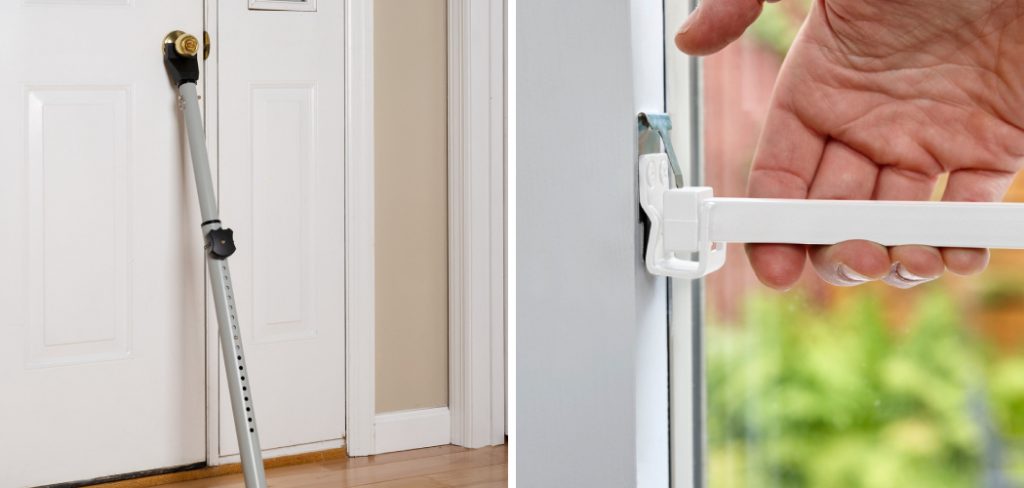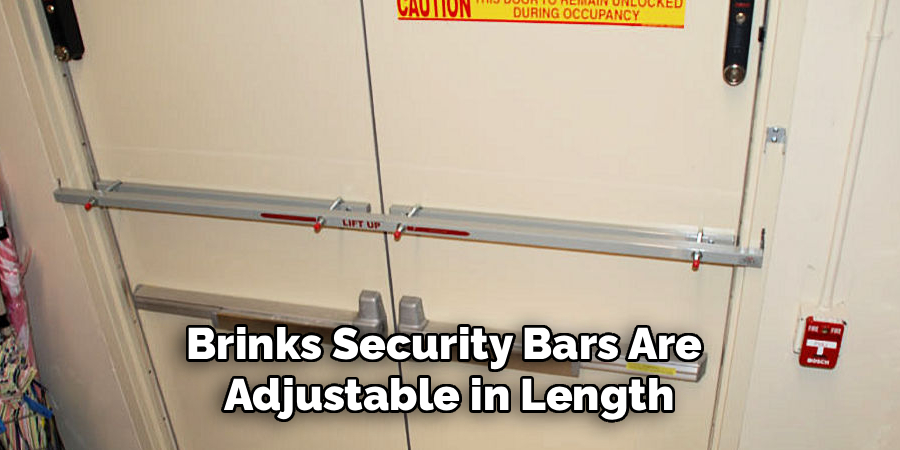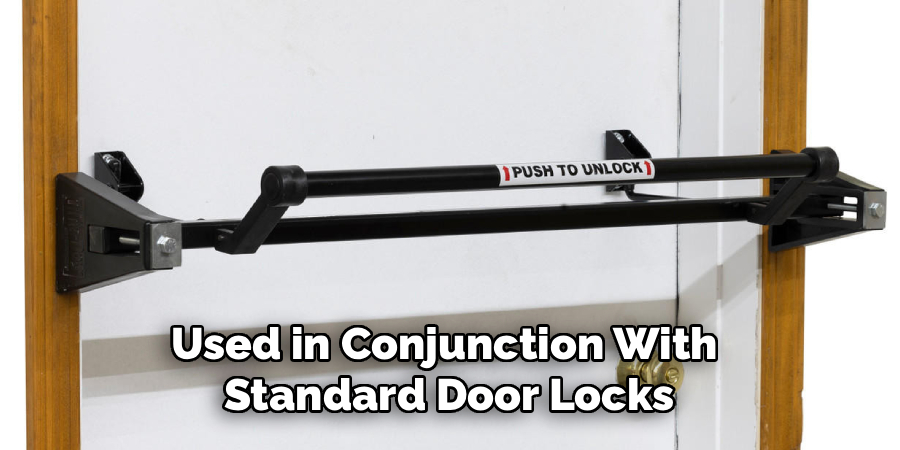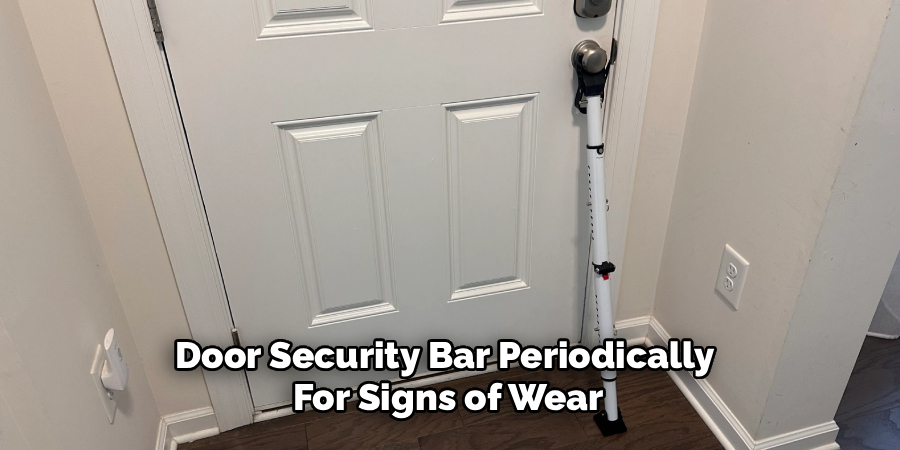Ensuring the safety and security of your home is a top priority, and the Brinks Door Security Bar is a reliable tool to enhance your home protection. This versatile and easy-to-use device is designed to reinforce doors against unwanted entry, providing an additional layer of security. Whether you’re at home or away, the Brinks Door Security Bar offers peace of mind by helping safeguard your property and loved ones. In this blog post, we’ll walk you through the steps on how to use brinks door security bar so that you can get back to using it in no time! So grab your tools, and let’s get started!

What Is a Brinks Door Security Bar?
A Brinks Door Security Bar is a sturdy and reliable device designed to enhance the safety of your home by reinforcing entry points like doors against forced entry. Made from durable, high-strength materials, this security bar is adjustable, making it suitable for use on various types of doors, including hinged and sliding doors. Its non-slip rubber base ensures a secure grip on most surfaces, providing additional stability and peace of mind. Whether you’re looking to protect your home, apartment, or other property, the Brinks Door Security Bar is an effective and simple solution for bolstering your home security.
Safety Precautions Before Use
Before using the Brinks Door Security Bar, it is important to follow these safety precautions to ensure proper installation and effectiveness:
- Inspect the Product – Carefully examine the security bar for any signs of damage or wear. Do not use the product if it appears to be compromised in any way.
- Check Door Compatibility – Ensure that the security bar is compatible with the type of door you intend to secure, whether it’s hinged or sliding.
- Test Surface Stability – Verify that the surface where the rubber base will rest is clean, dry, and free of debris to maintain optimal grip and prevent slippage.
- Regularly Reassess Tightness – After setting up the security bar, periodically check that it remains snug against the door to avoid accidental loosening over time.
- Read the Instructions – Familiarize yourself with the user manual provided by the manufacturer for specific guidance on setup and troubleshooting.
Taking these precautions helps ensure the Brinks Door Security Bar performs effectively and contributes to the overall safety of your space.
Tools You Might Need
To set up and maintain your Brinks Door Security Bar effectively, you may require the following tools:
- Screwdriver – Useful for adjusting any screws or securing additional fixtures, depending on your door type.
- Measuring Tape – Ensures accurate positioning and alignment of the security bar for optimal performance.
- Rubber Mallet – Helps with gentle adjustments without causing damage to your door or frame.
- Cleaning Cloth – Handy for wiping down the areas of contact to prevent dust or dirt from impeding the bar’s grip.

While the security bar is designed for ease of use, having these tools on hand can assist with installation, adjustments, or upkeep, ensuring long-term durability and safety.
10 Methods How to Use Brinks Door Security Bar
1. Select the Correct Type of Brinks Security Bar
Brinks offers several models of security bars, including adjustable bars for doors of varying widths and heights. The first step in effective usage is selecting the right type for your door. Adjustable bars are ideal for interior doors, sliding doors, or entry doors, while fixed-length bars may suit specific door sizes. Ensure that the bar you select can extend to fit snugly between the floor and the door handle or door frame. Choosing the correct bar ensures a secure fit and maximizes the barrier’s effectiveness against forced entry.
2. Position the Bar Properly
Proper positioning is essential for the Brinks Door Security Bar to function correctly. For standard swing doors, place the bar so that one end rests against the floor and the other presses firmly against the door handle or knob. Typically, the bar should be angled slightly toward the door to create leverage, which prevents the door from being forced open. For sliding doors, position the bar horizontally across the door track to block movement. Correct positioning ensures that the bar bears the force of any attempted entry, enhancing its security performance.
3. Adjust the Bar to Fit Your Door
Most Brinks security bars are adjustable in length. To fit the bar to your door, unlock the adjustment mechanism—usually a telescopic section or locking pin—extend the bar to the required length, and lock it securely. Ensure that the bar is taut between the door and the floor or track, as a loose bar reduces its effectiveness. Adjusting the bar properly allows it to withstand significant pressure, making it more difficult for intruders to force the door open.

4. Use a Non-Slip Base or Footpad
Many Brinks Door Security Bars feature a rubber or non-slip foot at the floor end. This prevents the bar from sliding when pressure is applied. Before securing the bar, ensure that the footpad is firmly in contact with a clean, flat surface. For doors on uneven or slippery floors, consider placing a thin rubber mat beneath the footpad to enhance friction. A stable base increases the bar’s resistance to force and prevents accidental slippage that could compromise security.
5. Engage the Bar Against the Door Handle Correctly
For door knob or lever-style handles, ensure that the top end of the security bar rests firmly against the handle or lock. The bar should not slip off when pressure is applied. Some models come with a padded handle end to prevent damage to the door hardware. Positioning the bar securely against the handle distributes force effectively and ensures that the bar cannot be easily dislodged during an attempted break-in.
6. Reinforce Doors With Multiple Bars
For high-risk entry points or larger doors, using multiple Brinks security bars can enhance protection. Position one bar at the usual height near the handle and another lower on the door or across a secondary lock or latch. This layered approach increases the difficulty for intruders and adds redundancy to your home security system. While a single bar is often sufficient, using multiple bars on vulnerable doors creates a stronger mechanical barrier.
7. Combine the Bar With Existing Locks
A Brinks Door Security Bar is most effective when used in conjunction with standard door locks or deadbolts. Ensure that your primary lock is engaged before installing the bar. The bar acts as a secondary layer of protection, reinforcing the door and preventing it from being forced open even if the lock is compromised. Combining mechanical reinforcement with traditional locks significantly improves the overall security of your entryway.

8. Test the Security Bar for Stability
After installation, test the security bar by applying moderate pressure to the door from the outside. The door should remain firmly closed without shifting the bar. Adjust the bar if necessary to eliminate any slack. Regularly testing the bar ensures that it remains functional, stable, and ready to withstand any potential intrusion attempts. This preventive check is an important part of maintaining home security.
9. Remove or Store the Bar Safely When Not in Use
If the door needs to be opened frequently, such as in a busy household or office, remove the bar when access is required. Store it in a secure, dry location to prevent damage or warping. Some models come with wall-mount brackets or hooks for convenient storage. Proper storage extends the life of the bar and ensures it is available when additional security is needed, especially during nighttime or absence periods.
10. Maintain the Bar for Long-Term Use
To ensure long-term effectiveness, inspect the Brinks Door Security Bar periodically for signs of wear, rust, or damage to the footpad or adjustment mechanism. Clean the bar with a damp cloth to remove dirt or debris that could affect friction or stability. Lubricate moving parts lightly if necessary. Maintaining the bar keeps it reliable and ready for use at all times, maximizing the security of your home.

Troubleshooting Common Issues
Even with proper use and maintenance, you may encounter occasional issues with the Brinks Door Security Bar. Below are some common problems and troubleshooting tips:
- Bar Slipping on Smooth Floors
If the bar doesn’t stay in place on tile, hardwood, or other smooth surfaces, ensure the rubber footpad is clean and free of dust or debris. For additional grip, consider placing a non-slip mat under the footpad for extra stability. - Difficulty Adjusting the Length
If the telescoping mechanism becomes stiff or hard to adjust, check for dirt or residue on the adjustable sections. Clean them with a damp cloth and dry thoroughly. If the issue persists, apply a small amount of lubricant to the telescoping parts to improve movement. - Footpad Losing Grip
Over time, the rubber footpad can wear out, reducing its grip. Inspect the footpad regularly and replace it if it shows significant signs of wear or damage. Contact the manufacturer or an authorized retailer for replacement parts. - Bar Not Fitting Properly Under Door Handle
Ensure the bar is angled correctly and firmly positioned under the door handle. The angle should allow the bar’s footpad to create strong contact with the floor. If the fit is still problematic, verify that the bar’s length is correctly adjusted for your door’s height.
Addressing these issues promptly helps maintain the reliability and security provided by the Brinks Door Security Bar. If problems persist despite troubleshooting efforts, consult the manufacturer’s customer support for further assistance.
Conclusion
A Brinks Door Security Bar provides a simple yet highly effective way to reinforce doors and enhance home safety. By selecting the correct bar, positioning it properly, adjusting it to fit, using non-slip bases, securing it against the door handle, and combining it with existing locks, you create a robust defense against forced entry. Thanks for reading this blog post on how to use brinks door security bar! We hope you found it helpful and informative.
About
Safety Fic is a distinguished figure in the world of Diy design, with a decade of expertise creating innovative and sustainable Diy solutions. His professional focus lies in merging traditional craftsmanship with modern manufacturing techniques, fostering designs that are both practical and environmentally conscious. As the author of diy, Safety Fic delves into the art and science of Safety Fic-making, inspiring artisans and industry professionals alike.
Education RMIT University
(Melbourne, Australia) Associate Degree in Design (Safety Fic) Focus on sustainable design, industry-driven projects, and practical craftsmanship. Gained hands-on experience with traditional and digital manufacturing tools, such as CAD and CNC software.
Nottingham Trent University
(United Kingdom) Bachelor’s in diyfastly.com and Product Design (Honors) Specialized in product design with a focus on blending creativity with production techniques. Participated in industry projects, working with companies like John Lewis and Vitsoe to gain real-world insights.
Publications and Impact
In diy, Safety Fic his insights on indoor design processes, materials, and strategies for efficient production. His writing bridges the gap between artisan knowledge and modern industry needs, making it a must-read for both budding designers and seasoned professionals.
